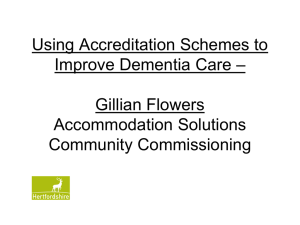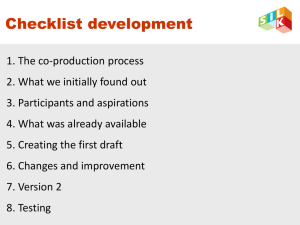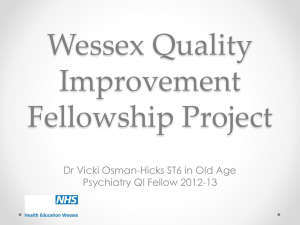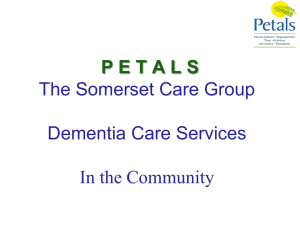Dementia, insecurity & reassurance, 31st october 2013
advertisement
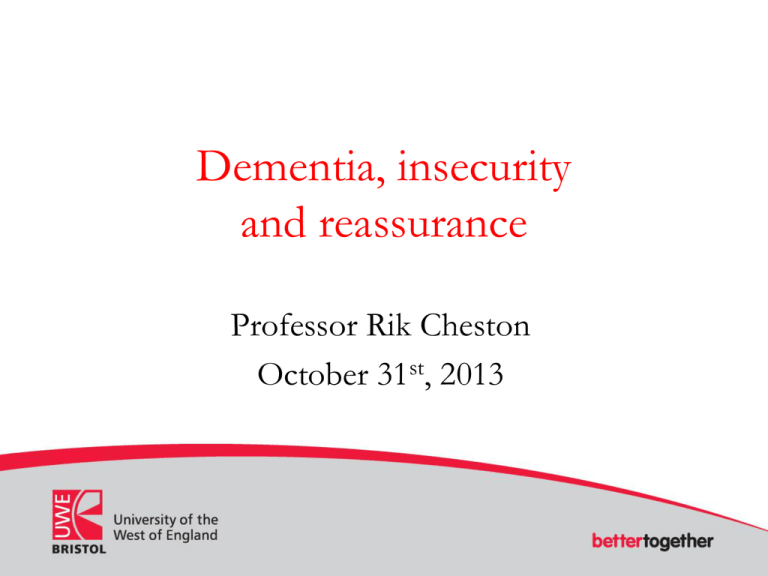
Dementia, insecurity and reassurance Professor Rik Cheston October 31st, 2013 Exercise • Think of a time in your life when you had to deal with a new situation – perhaps your first day in a new job, or when you travelled abroad – a time when you felt on your own in unfamiliar surroundings • How did you feel? • What did you do? • What made you feel better? • What made you feel worse? How does insecurity affect people? • We learn how to cope with feelings of insecurity as children • People cope with their feelings of insecurity differently – find different ways of making themselves feel better – New situations → feelings of insecurity → attachment seeking behaviour → feeling better • We continue to use these different “styles” of coping throughout our life • The cycle of attachment behaviour may be triggered by changes in life .... including dementia? Bére Miesen –linking attachment and dementia • Dementia makes it harder – to recognise people and places or to make sense out of what is happening, – to remember information, or – to find words to describe what is happening • Roles and relationships change become dependent on others • Become introduced to new places and situations Dementia undermines security • Cognitive impairment – – – – – – Harder to remember information, Harder to recognise people and places Harder to make sense out of what is happening, Harder to find words to describe what is happening Harder to do things you used to do Harder to hold onto continuity in life. • Psychosocial changes – Roles and relationships change - become dependent on others – Become introduced to new places and situations • Is dementia a permanently “strange situation”? Dementia and insecurity • People with dementia are often anxious or agitated – and do things to make themselves feel better - attachment-seeking behaviour – They may “shadow” a husband or wife – May be worse when they are apart from their families – They may accuse their husband or wife of being unfaithful – They may want to go back to a previous home – They may imagine that their parents are still alive – Hiding things – Shouting for help Examples • Jane Harris – lives in a Nursing Home, repeatedly asks when breakfast/lunch/tea will be, what she has to do next. Seems anxious, worried and uncertain • Mrs Prichard - always seems busy, wanders around the Nursing Home, trying doors and looking in boxes. When she opens the boxes she doesn’t seem to know what to do, fiddles with what is inside and tries to replace it. Doesn’t talk or interact much with other people • John Smith – in-patient on a ward, staff find him trying to get out of a window and he insists on going home – angry and upset Challenging behaviour and insecurity • Different ways of reacting to insecurity • Attachment behaviour can be counter-productive • Creates stress for others • Which in turn leads to greater insecurity • Dementia “permanent feeling of insecurity” → attachment seeking behaviour → care giver retreats, is unavailable, ineffective → feeling worse 1. Routine and structure … • Important for some people to know where they are and what they are doing – Time of meals – What is happening next – Who is in charge – What they can do – need to be active and have a role 2. Developing relationships Generally, the most effective way to build security is through developing new relationships through which the individual can come to feel more valued and understood This works best if there is consistency, good personal and communication skills and time to develop relationships • Emotions are remembered in a different way to facts • People with dementia remember feelings about people better than they remember facts 3. Attachment (transitional) objects • We can become attached to things, not only to people. Those things can have the power to soothe, or reassure us. – Favourite coffee cup – A chair they like – Handbags, hats, sticks, glasses • People can also put other emotions into objects – anger, rage, grief, happiness. • Transitional phenomena and activities Use of objects or dolls, Mackenzie (2006) • Introduced 14 dolls into two residential homes. – Staff initial concerned, but felt there were clear benefits – that they felt their residents’ lives had improved as a result – Felt that dolls improved communication. • Residents tended to be more active, showed greater levels of interaction with staff and fellow residents, appeared happier, less agitated and more amenable to personal-care activities. • Some concerns: – arguments about ownership – concerns of relatives Use of objects in a Nursing Home (Ashurst, 2010) • Looked at whether residents with dementia used objects as transitional objects – i.e. that they helped reduce anxiety • Many residents used these objects to help make themselves feel more secure • Objects could be anything from a doll to a handbag, stick or cushion - “conjured up” a sense of the important figure(s) in their life • Residents may lose ability to use objects in this way – but still able to get comfort from them – through sucking or through touch Loving and hating • Henry wakes and picks up Popeye. He holds the doll’s nose to his nose and rubs noses with him. He lifts Popeye up higher and then bounces him on his knee. He lifts him up as high as he can and brings him down saying ‘Weeeee’. He then cuddles Popeye hard holding him to his chest and vigorously pats his back saying ‘Ahhhh’. Henry holds Popeye tight and rocks him hard Our research so far … • SPT stands for Simulated Presence Therapy – we used a personal walkman to play the message ...!! • Involves asking people with dementia to listen to a recording of their husband or wife’s voice when they are separated from them • So far we have carried out 3 small research projects involving 11 people with dementia across 55 different trials of SPT • Now we use cards – Personal messages Jane – 84 years old, with dementia – 10 sessions of SPT on a ward 45 40 A1 A2 35 30 SPT 25 20 15 10 5 0 Fear Happiness Negative Vocalisations Positive engagements Total negative Total positive beh beh Average levels of behaviour for six participants 80 70 60 A1 50 SPT 40 A2 30 20 10 0 Vocalisation Looking at others Initiating Engagement interactions What is the effect of SPT? • While the tape was playing, most of the 11 participants talked more, seemed to be happier and less anxious or sad • This impact carries over into the immediate period after the tape ends – participants seemed to be less distressed and interacted more with other people • However, significant differences between individuals – some appear indifferent, one person seemed to be reminded of her husbands’ absence • For everyone, the impact of the tapes decreased over time • But SPT is rarely used – too difficult to make recordings, too time consuming for staff to use Overview • Dementia is often (always?) a time of insecurity • People respond to this and express their distress in different ways – may be very challenging • Often this is mistaken for the dementia itself – trying to “control” behaviour may make things worse • Providing security is a fundamental part of working with people with dementia



